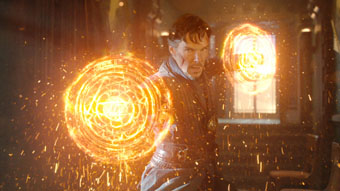
Image courtesy Marvel Comics/Walt Disney Studios
Doctor Strange:
Dazzling Visual Fun
| published November 12, 2016 |
By Cameron Dale, Thursday Review contributor
We could use this guy in the hours and days after the election, but, alas, he is but a comic book hero, one of many members of the Marvel Comics galaxy of characters and creatures, but one perhaps unable to cross the bridge long enough to help us decompress and detoxify now that Tuesday’s votes have been counted.
Doctor Strange has been around since the early 1960s, in print at least, and long before I was born. Still, I am surprised by the numbers of folks I know who know little of his backstory and his roots in the comic book world order. An odd subchapter to the long run-up to this week’s release of the film Doctor Strange is the fact that a movie based on his fictional exploits has been rattling around from one major studio to another since 1985, when the first treatment was seriously considered. Thankfully, in that age of lesser special effects, no such movie ever emerged. This is clearly a case where digital effects and the mastery of computer rendering is not merely a convenience, but in fact essential to make this sumptuous film dazzle.
More to the point, the appearance of Doctor Strange in a new film released by Marvel Studios and Walt Disney shows the full power of comic book characters—not to bend matter or fly at subsonic speeds or catch falling airplanes, but to command big dollars at the box office. The heavily promoted movie (you may have caught the commercials wedged between relentless ads for Clinton, Trump and your local hooligan-politicians) opened last week to generally good reviews, suggesting it might avoid the fan dissatisfaction and the critical problems which befell Suicide Squad (which made big bucks anyway) and Mattel’s Max Steel, which was a big metallic bust.
The plot is hardly simple, nor easy to explain. But in the spirit of these things here you go. A well-known and respected neurosurgeon, Dr. Stephen Vincent Strange (Benedict Cumberbatch), is severely maimed in a terrible car accident, losing the use of his hands—thereby ending, in theory, his earthly power to repair and heal. In a fruitless effort to regain his hands and his surgical dexterity, his tries any manner of weird experiments and bizarre treatments, only to find failure, exhaustion and deeper frustration.
Despondent, he turns to an Eastern mystic and sorcerer in Nepal (or maybe it is Tibet) who is alleged to have helped a famous paraplegic (Jonathan Pangborn, played by Benjamin Bratt) walk again and aided others in remarkable and unlikely recoveries. Strange travels to the Himalayas, where he receives spiritual and physical guidance, as well as training in the ways of sorcerers and mystics, including the use of telekinetic powers. He learns of such oddities as Astral Planes and Mirror Dimensions, and also discovers that Earth is generally protected from outside evils—like horrible aliens and megalomaniac bad guys—through the power exerted by the three Sanctums, structures found inside buildings in London, New York, and Hong Kong. It is the job of good guy sorcerers to protect these objects.
All fine and good, except that not everything is as it should be in these mystical places. And bad super villains are working diligently to channel the power of sorcery and telekinesis to their own evil and wicked ends. This sets up our man Doctor Strange on a mission—along with a few allies—to an inevitable series battles with the villains, who include a sorcerer named Kaecilius (played with wonderfully evil gusto by Mads Mikkelsen) and his followers. Kaecilius, as it turns out, has summoned the darkest powers of sorcery and tapped into a dimension in which evil can endure without physical limitation and without fear of death. It’s a wicked combination: think of The Joker if he were given an immortality pill.
Kaecilius and Strange also each learn how to bend, manipulate and even roll back time—including its physical consequences. This leads to several very intense confrontations, including one in which about half of downtown Hong Kong is destroyed. More about that in a moment.
Sometimes special effects can overpower and ruin a movie. Such is not the case here. The effects are dazzling and deliriously fun, and well within the range of the storytelling intended by director Scott Derrickson. This is definitely a case of special effects strengthening the film without detracting from the story, which, as it turns out, requires lots of eye-popping stuff.
Example: one particularly impressive scene involves some of the good guys—led by Strange—battling Kaecilius and his cabal in the streets of Hong Kong, where buildings topple and dozens of city blocks are set ablaze, only to have Strange bend and reverse time, with buildings setting themselves aright and burst water lines sealing themselves and shattered glass merging back into its original form, all while the two sets of antagonists fight in real time, which is to say forward time. Confused yet? See the movie, everything will be illuminated.
The short version on Doctor Strange: lots of visual fun threaded into a the story of a character with an interesting outlook on the world. I recommend this to anyone who loves action, adventure and fantasy, or the Marvel body of work.
Related Thursday Review articles:
Suicide Squad; Maggie Nichols; Thursday Review; September 3, 2016.
The Accountant; Cameron Dale; Thursday Review; October 26, 2016.
